
Various trial weapons of Project Abakan.
Project Abakan was a Russian assault rifle trial began in early 1980s, aimed at finding a replacement for the AK-74. This program could be seen as an eastern counterpart to the American Advanced Combat Rifle Program.
Goal[]
The goal of Project Abakan was to find a weapon that could effectively replace the AK-74, which replaced the AK-47. The problem with the AK-74 was its low accuracy with short bursts of fire. As such, the project's main goal was to produce a weapon that had good accuracy, even with short bursts of fire.
Entrants[]
There were five different bureaus in the competition, PO Izhmash, TsKIB SOO, SKB KMZ, TsNIITochMash and IzhNITI.
- TsKIB SOO
- TKB-0111, designed by German Alexandrovich Korobov
- TKB-0136-3M, designed by Nikolay Mikhaylovich Afanasyev
- TKB-0146, designed by Igor Yakovlevich Stechkin
- SKB KMZ
- AEK-971 and AEK-973S designed by Stanislav Ivanovich Koksharov
- AEK-978, designed by P. A. Pikinsky
- PO Izhmash
- AL-9, designed by Victor Mikhailovich Kalashnikov
- AKB and AKB-1, designed by Victor Mikhailovich Kalashnikov
- AS and ASM, designed by Gennadiy Nikolayevich Nikonov, produced in many variants
- AS-1
- ASM
- ASM OK-158
- AS WS-229
- ASM MA-49
- ASM MA-50
- NA-2 and NA-4, designed by Gennadiy Nikolayevich Nikonov
- A-11, designed by Gennadiy Nikolayevich Nikonov
- AU, designed by Gennadiy Nikolayevich Nikonov
- TsNIITochMash
- AO-63, designed by Sergei Gavrilovich Simonov and Peter Andreevich Tkachev
- IzhNITI
- APT, designed by Igor A. Postnikov
Selection Process[]
First round[]
In August 1984, eight designs were ready for testing by eight designers. These were:
- Korobov's TKB-0111
- Afanasyev's TKB-0136-3M
- Stechkin's TKB-0146
- Koksharov's AEK-971
- Pikinsky's AEK-978
- Kalashnikov's AL-9
- Nikonov's AS
- Postnikov's APT
After which, the Russian Ministry of Defence and GRAU reviewed all designs and to see if they met the required specifications. Two designs were eliminated from the start:
- Postnikov's APT - unreliable
- Korobov's TKB-0111 - least promising
The remaining six designs went through 18 months of further development and improvements to accuracy.
Second Stage[]
Following the 18 month development period, in May to June 1986, changes were made to the prototype lineup. The prototype lineup as of May to June 1986 was as follows:
- Afanasyev's TKB-0136-3M
- Stechkin's TKB-0146
- Koksharov's AEK-971
- Pikinsky's AEK-978
- Kalashnikov's AKB
- Nikonov's AS
- Simonov-Tkachev's AO-63
As shown in the table, the AL-9 was pulled out for unknown reasons and replaced by the AKB, while a new prototype, the AO-63, was brought in. More tests were performed, such as firing a high volume of rounds in various conditions. However, no weapon fully met the requirements. In spite of this, the AS and AO-63 met the requirement of accurate groupings. As such, designers were given 3 months to update their designs, before the same tests were repeated in October 1986. Two designs were modified fundamentally for the tests:
- Nikonov's AS (became the ASM with certain refinements)
- Kalashnikov's AKB (became the AKB-1 with the BARS system added)
Further developments of the prototypes were limited to muzzle devices. Halfway through these tests, three designs were eliminated:
- Afanasyev's TKB-0136-3M
- Koksharov's AEK-971
- Kalashnikov's AKB-1
All were eliminated for the same reason; it was not practical or viable to continue work on these three weapons. In spite of this, the AEK-971 was fielded with Russian forces later on and is currently in use with the Russian army.
Final Stage[]
In the final stage, the lineup for prototypes was as follows:
- Nikonov's ASM
- Stechkin's TKB-0146
As shown in the table, the Pikinsky design (the AEK-978) and the Simonov-Tkachev design (the AO-63) did not make it into the final round for unknown reasons. Both the TKB-0146 and AS showed excellent accuracy, with testers noting the great comfort they had when shooting them, and could fire a two-round burst so quickly that it sounded like a single shot. The trajectory of the bullets could also be seen.
Overall Results[]
As with any competition, there can only be one winner. Eventually, one of two designs was eliminated:
- Stechkin's TKB-0146
While more accurate than the other design, it was less reliable as it accumulated more fouling problems. As such, the winner of the competition was chosen, the Nikonov ASM, which was then fielded and designated the AN-94.











